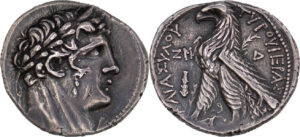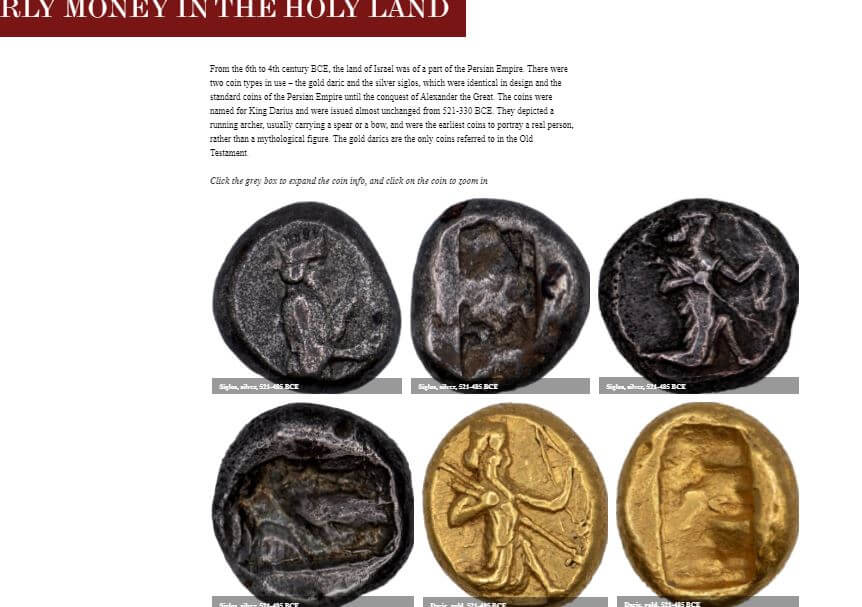The Four Coins Jesus Knew
“Coins of Jesus: Money and Religion in the Ancient World” is a virtual exhibition that highlights Judeo-Christian coinage in the Numismatic Collection of Nickle Galleries at the University of Calgary. The virtual version is based on the popular 2017 exhibition, and includes high-quality images of 94 coins, now in public domain and free for non-commercial use.
“Coins of Jesus” examines the world’s religious and cultural history through ancient money. It begins with the Persian Imperial coinage – the only coins referenced in the Old Testament, and showcases numerous stunning examples, such as the renowned Phoenician shekels, rare Jewish YHD issues, historic coins of Pontius Pilate and the Jewish-Roman Wars, culminating with the very first Christ coins from Byzantium. The journey ends with Europe’s Medieval Christian silvers and the almost forgotten 7th century Islamic coinage with the frontal image of Caliph Alb al-Malik.

Jesus Christ on a gold tremissis issued by the Byzantine Emperor Justinian II, 685-695. Nickle Galleries, University of Calgary. Photo: Brittany DeMone.
Coins That Jesus Knew
The exhibition is centered on the four coins directly linked to historic Jesus.
According to the Gospels, Jesus was well aware of the importance of money. He most likely handled silver, bronze and gold coins, both local and from the neighboring regions – Jewish, Greek, Roman, Syrian, Nabatean, Egyptian, all present in Judea at the time. However, there are four coins directly linked with Jesus in the New Testament: Phoenician shekel and half-shekel, Jewish Hasmonean lepton, and Roman denarius.

Silver shekel, Melqart / Eagle, 80-79 BCE. Tyre, Phoenicia. 1990.1.137. Nickle Galleries. Photo: Brittany DeMone.
The most fascinating Phoenician shekels, minted in the city of Tyre 126/5 BCE-66/67 CE, were of pure silver, true weight, and came in two denominations: half shekel (8g) and full shekel (14g). The half shekel is referred to in the New Testament, specifically in Matthew’s passages on the Jewish Temple tax (17:24-27). The payment is first mentioned in Exodus in the Old Testament, which states that every Jewish male over 20 years of age has to pay a tax to the Temple in Jerusalem, originally half a shekel weight equal to twenty gerah (30:11-16). Later on, the weight measurement was converted to a half-shekel coin, and according to the Jewish historian Josephus, the annual monetary tribute of the half-shekel was equivalent to two Athenian drachms (The Jewish War, 7.6.6). As a Jewish male over 20, Jesus had certainly paid the annual tax for at least a decade (Matthew 17:24).
When it comes to the full shekel, the most prominent New Testament reference is in the account of Peter finding the coin for the tax payment in the mouth of a fish (Matthew 17: 24-27). The story includes a discussion between Jesus and Peter about payment of the taxes levied by the “kings of the earth,” and the miracle according to which Peter finds a stater (στατῆρα), which equals four drachms or a shekel, in the mouth of a fish, which is then used to pay the Temple tax for both of them.
Additionally, the story of Jesus and the money changers indirectly implies the presence of Tyrian shekels (Mark 11:15-17). The money changers were in the Temple to convert various currencies into one standard coinage, the Tyrian shekel, that was used for the payment of the already-mentioned Temple tax. The worshippers used the moneyers’ services to exchange their baser common currency for the high-quality silver shekels, and it can be safely assumed that the money changers’ tables were full of these coins. For example, Roman coinage was generally only 80% silver while the Tyrian silver was 94% or more pure.
Last, the same shekels are believed to be the infamous “30 pieces of silver” paid from the Temple treasury to Judas for his betrayal of Jesus (Matthew 26:14-15). This is confirmed by a 2nd century compilation of the Jewish oral law, which states, “Silver, whenever mentioned in the Pentateuch, is Tyrian silver” (Tosefta Ketubot 13, 20). The most intriguing fact about these shekels however is that they depict Melqart, the patron deity of Tyre, a possible contradiction to the Jewish law regarding graven images as well as the question of the coins’ holy purpose. There are no definite answers to this phenomenon, yet some believe that money was and still is outside that code, which in general is an intriguing notion.

Bronze lepton, Inverted anchor/Sun-wheel, 103-76 BCE, Alexander Jannaeus, Hasmonean Dynasty, Judea. De Groot Collection. Nickle Galleries. Photo: Brittany DeMone.
Lepta (sg. Lepton) were the low-quality bronze coins minted by the Hasmonean Dynasty in the 1st century BCE. They were the smallest, almost worthless coins still in circulation in the time of Jesus. Many believe that these were the coins mentioned in the story of the poor widow who gave two small copper coins to the treasury while Jesus was watching (Mark 12:41-44). Because of that reference, they are commonly referred to as “Widow’s Mites.”

Silver denarius, Tiberius/Personification of Peace (Livia), Emperor Tiberius, 14-37, Rome. 1990.3.1. Nickle Galleries. Photo: Brittany DeMone.
The fourth coin is cited in the story of the Roman Tax, and thus often called “the Tribute Penny” (Mark 12:14-17). The coin was shown to Jesus when he made his famous speech “Render unto Caesar…” (Matthew 22:21). The phrase comes after Jesus was asked, “Is it lawful to pay taxes to Caesar, or not?” (Mark 12:14) and he replied, “Bring me a denarius [δηνάριον] and let me look at it” (Mark 12:15). Based on many clues, the Roman silver denarius minted by the Emperor Tiberius (14-37) is considered to be that coin.
The Nickle Numismatic Collection is the leading academic numismatic collection in Canada, consisting of over 23,000 objects including coins, paper money, tokens, medals and pre-coinage currencies, from the 7th century BCE to the present day, with a focus on the ancient Greek and Roman coinage. The Nickle curates annual exhibitions, organizes public talks, workshops, lectures, and works closely with students, faculty and the wider campus community.
Here you can visit the online exhibition “Coins of Jesus”.
Curator Marina Fischer presented some coins of the Bible:
You are currently viewing a placeholder content from YouTube. To access the actual content, click the button below. Please note that doing so will share data with third-party providers.
Expert David Hendin wrote a couple of articles for CoinsWeekly on Jewish numismatics and shekels from Tyre that are always worth re-reading:
In this video David Hendin gave a brief overview on coins from the Jewish War.
This article gives also an excellent overview on coins in ancient Israel. It presented an exhibition in Vienna’s Kunsthistorisches Museum in 2015: “Coinage and Power in Ancient Israel”.













